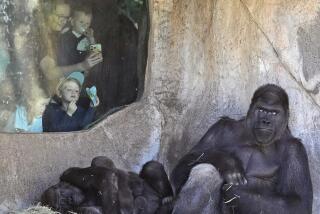For dung beetles, Milky Way is guiding light
When humans gaze up at the night sky, they may view the fuzzy streak of the Milky Way and contemplate their place in the universe.
When dung beetles see the Milky Way, their thoughts turn to keeping their food source away from other insects.
Scientists have found that these inch-long creatures use the glowing edge of the galaxy to guide them as they roll their balls of dung across the African landscape. The report, published online Thursday by the journal Current Biology, provides the first documentation of animals using the Milky Way for navigation.
Considering that birds, seals and butterflies are known to rely on the stars to find their way around, the study authors noted that using the Milky Way as a compass “might turn out to be widespread in the animal kingdom.”
If any bug needs a straight line to follow, it’s the dung beetle. These nocturnal insects make a habit of balling up pieces of animal manure and rolling the spheres away from the larger pile to save for their own use. The balls, which are considerably bigger than the beetles’ bodies, serve as food and even a nesting place for some species.
Given the importance of these dung balls, it’s essential that the beetles keep them away from any would-be thieves. Hence the importance of rolling in a straight line: If they take a curvy route, they could mistakenly wind up back where they started, giving other beetles a chance to steal it.
“The whole point of moving the ball away is to avoid the competition,” said Keith Philips, a dung beetle expert at Western Kentucky University in Bowling Green, who wasn’t involved in the new study. “Stop wasting energy moving your ball around.”
Vision scientist Marie Dacke of Lund University in Sweden, who led the study, had noticed in previous studies that even on moonless nights, dung beetles were able to move their spheres in straight paths. To put the critters’ routing skills to the test, she and her colleagues tracked their insect subjects through a dung-rolling course on a South African game reserve called Stonehenge.
The researchers put the beetles and their balls of dung in the center of an arena of sand surrounded by a meter-high wall so nothing on the ground could be used as a point of reference. An overhead camera filmed their paths.
The beetles’ performance was telling. On clear nights when the moon and stars were visible, the insects’ trajectories were more or less straight. Even on a moonless night, the beetles were pretty efficient in their dung-rolling as long as the Milky Way was visible. But when the sky was overcast, the insects went every which way but straight.
In a second round of experiments, the researchers put the bugs and their dung balls in the center of a wooden platform two meters across and clocked how long it took for them to reach the edge. With the galaxy in sight, their paths led them to the edge of the platform in as little as 40 seconds. But with clouds blocking their view, it took them nearly two minutes.
The researchers even taped makeshift cardboard visors to the beetles’ heads, blocking their view of the sky to eliminate all doubt. To no one’s surprise, the beetles wandered aimlessly, showing no sense of direction.
Were the dung beetles navigating by the stars or the Milky Way? To find out, the researchers repeated some of their experiments inside a planetarium in Johannesburg.
When the beetles labored under a simulated sky lit only by the Milky Way’s glow, the insects and their dung balls reached the edge of the platform in about 50 seconds. When the galaxy was removed and only the sky’s brightest stars were visible, the task took just over a minute.
“This clearly shows that the beetles do not orientate to a single bright ‘lodestar,’ but rather to the band of light that represents the Milky Way,” the researchers concluded.
The findings have made the scientists wonder about other species. Cricket frogs travel in only two directions on moonless nights, they noted in their study; perhaps they use the Milky Way’s glow for orientation too.
Bradley Mullens, an entomologist at UC Riverside, said the research team’s suspicion was probably correct.
“I would not be surprised if other nocturnal insects — or maybe other animal groups — might be able to use a diffuse but directional cue such as the Milky Way,” said Mullens, who wasn’t part of Dacke’s team. “Maybe this paper will stimulate more studies of that nature.”
More to Read
Start your day right
Sign up for Essential California for news, features and recommendations from the L.A. Times and beyond in your inbox six days a week.
You may occasionally receive promotional content from the Los Angeles Times.







